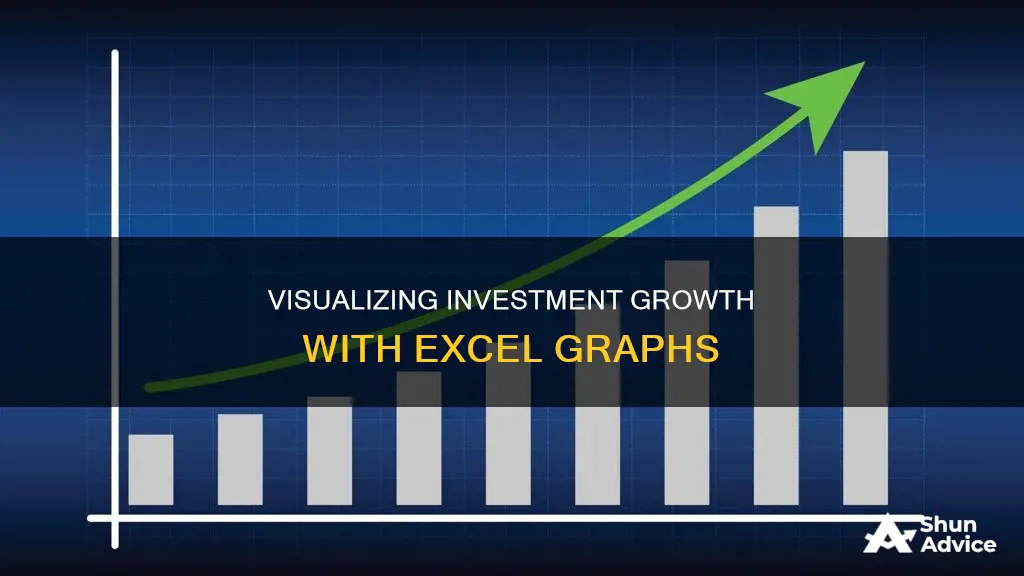
Microsoft Excel is a powerful tool for calculating and visualizing investment growth. It offers a range of formulas and functions, such as the Future Value (FV) function, the Internal Rate of Return (IRR) function, and the Compound Annual Growth Rate (CAGR), to help investors understand the performance of their investments and make informed decisions. By inputting data such as the principal amount, interest rate, time, and compounding frequency, individuals can track and predict the growth of their investments over time. Excel also allows for customization and flexibility in creating charts and graphs, making it easier to visualize and communicate complex financial data to stakeholders. With its array of features, Excel empowers users to achieve their long-term financial goals and make data-driven investment choices.
| Characteristics | Values |
|---|---|
| Purpose | To calculate and visualise investment growth |
| Data | Principal amount, interest rate, time, compounding frequency |
| Types of Investment Growth | Simple interest, compound interest |
| Formulas | FV, IPMT, XNPV, CAGR, GROWTH |
| Functions | PMT, IRR, STDEV |
| Visualisations | Line chart, bar chart, pie chart, scatter plot, histogram, area chart, waterfall chart |
What You'll Learn

Creating a growth chart
Step 1: Prepare Your Data
Before creating the chart, ensure you have your investment data ready in Excel. You'll need information such as the date, entry price, number of shares, periodic closing prices, and any returns for each investment. Organize this data in a tabular format, with each investment or time period represented by a row and relevant data in separate columns.
Step 2: Calculate Growth Rates
To calculate the growth rate for each investment or time period, you can use the following formula:
> Growth Rate = ((Ending Value - Starting Value) / Starting Value) * 100
In Excel, you can apply this formula to a single pair of values or use the fill handle to calculate growth rates for multiple pairs of values. Simply enter the formula in the first cell, click on the fill handle at the bottom-right corner of the cell, and drag it down the column to fill the formula in the additional rows. Ensure you format the growth rates as percentages.
Step 3: Select Your Data Range
Once you have calculated the growth rates, select the data range you want to chart, including the dates or time periods and the corresponding growth rates. You can do this by clicking on the top-left corner of your data table and dragging the selection to the bottom-right corner.
Step 4: Insert the Chart
Go to the "Insert" tab in the Excel ribbon and click on the "Chart" button. A gallery of chart options will appear. For growth charts, line charts or column charts are often used. Select the chart type you prefer.
Step 5: Customize Your Chart
After inserting the chart, you can customize its appearance and add elements to make it more informative. Here are some suggestions:
- Titles and Labels: Add a title to your chart that describes the data being presented. You can also add labels to the axes to indicate the date or time period and the growth rate values.
- Legend: Include a legend that explains the different components of your chart, such as the investments being compared.
- Trendline: Right-click on the data series and select "Add Trendline" to show the overall growth trend.
Step 6: Finalize and Style Your Chart
With your chart in place, you can now format it to match your preferences or your company's style guide. You can change the colors, fonts, and line styles to make your chart visually appealing and consistent with your brand.
Step 7: Analyze and Interpret
Your growth chart is now ready! Take the time to analyze the data presented and interpret the results. Look for trends, patterns, or anomalies in the growth rates. Compare the performance of different investments or time periods to gain insights that can inform your investment strategies.
H1B Visa Holder? Smart Investment Strategies for Your Savings
You may want to see also

Using the FV function
The FV function in Excel is a powerful tool for calculating the future value of an investment, taking into account compound interest. It's an essential function for anyone looking to make informed financial decisions and plan for the future.
Understanding the FV Function
The FV function, or Future Value function, is used to calculate the future value of an investment based on periodic, constant payments and a constant interest rate. It considers factors such as regular payments, interest rates, and the duration of the investment to provide a projection of your financial future.
The basic syntax of the FV function is as follows:
> FV(rate, nper, pmt, [pv], [type])
Here's a breakdown of each component:
- Rate: This is the interest rate per period. For annual interest rates, divide it by the number of periods in a year (e.g., 12 for monthly periods).
- Nper: Stands for the number of periods. It represents the total number of payment periods in the investment.
- Pmt: The payment made each period, which must remain consistent throughout the investment term.
- [pv]: Present value or the initial amount of the investment. This is an optional field, and if left out, Excel assumes it to be 0.
- [type]: Indicates when payments are due. Use 0 for the end of the period (default) and 1 for the beginning.
Setting Up Your Excel Sheet
Before using the FV function, you need to set up your Excel sheet with the necessary data. Here's a simple way to get started:
- Create a new Excel workbook and label your columns. You might include columns for Interest Rate, Number of Periods, Payment, and Present Value.
- Enter your data: Fill in the cells with specific values. For example, if you have a 5% annual interest rate, you would enter 0.05 in the Interest Rate column.
- Format your cells: Ensure your interest rate is in a percentage format, and your payment and present value are in currency format to avoid confusion.
Now that your sheet is set up, follow these steps to use the FV function:
- Select the cell: Click on the cell where you want the future value result to appear.
- Enter the FV function: Type =FV( into the selected cell. Excel will prompt you for each component.
- Add the rate: Click the cell containing your interest rate, and if necessary, divide it by the number of periods per year.
- Enter nper: Click the cell with the total number of periods (total number of payments).
- Include pmt: Click on the cell with your payment amount.
- Include pv (optional): If you have a present value, click the corresponding cell. Otherwise, you can skip this step or enter 0.
- Specify type (optional): Enter 0 or 1 to indicate whether payments are made at the end or beginning of each period.
- Close the function: Finish the formula with a closing parenthesis and hit Enter.
Practical Examples
Let's look at some practical examples to see how the FV function can be applied to different financial scenarios:
Example 1: Vacation Savings
You plan to save $200 a month for a dream vacation, with a 4% annual interest rate, compounded monthly, for three years. To calculate the future value:
> =FV(4%/12, 3*12, -200)
The future value will be approximately $7,656.20, giving you a comfortable budget for your vacation.
Example 2: Retirement Planning
For retirement, you decide to invest $500 a month at a 6% annual interest rate, compounded monthly, for 20 years. To find out the future value:
> =FV(6%/12, 20*12, -500)
This formula projects a future value of about $230,685.80, providing a substantial sum for your retirement years.
Tips for Advanced Users
Once you're comfortable with the basics, you can explore more advanced applications of the FV function:
- Variable interest rates: While the FV function assumes a constant rate, you can adjust your sheet manually for changing rates by recalculating the future value for each period and summing them up.
- Combining with other functions: The FV function pairs well with other Excel functions like SUM or IF to create complex financial models.
- Visualizing results: Utilize Excel's chart features to visualize your investment growth over time and gain clearer insights.
- Scenario analysis: Experiment with different scenarios by varying parameters such as rate, payment, and duration to observe their impact on future value.
Brexit-Proof Your Investment Portfolio: Strategies for Volatile Markets
You may want to see also

Calculating compound interest
To calculate compound interest in Excel, you can use the FV function, which stands for "Future Value". This function calculates the future value of an investment, taking into account a constant interest rate and optional periodic payments. The formula for this is:
=FV(rate, nper, pmt, [pv], [type])
- "rate" refers to the interest rate for each period
- "nper" is the number of periods
- "pmt" is the payment made each period (optional)
- "pv" is the present value or initial investment
- "type" is an optional argument to indicate when payments are due
For example, if you invest $1,000 at an annual interest rate of 5%, compounded monthly, for 10 years, the formula would be:
=FV(C6/C8, C7*C8, 0, -C5)
This formula returns approximately 1647 as the final result. This is the value of a $1,000 investment, compounded monthly with a 5% annual interest rate over 10 years.
Alternatively, you can use the Excel formula =$P*(1+R/T)^(N*T) to calculate compound interest, where:
- "P" is the principal amount
- "R" is the rate of interest
- "N" is the number of years
- "T" is the number of times the interest is compounded per year
For example, if you borrow $5,000 at a 5% interest rate for 10 years, the formula would be:
= $5000*(1+5%/1)^^(10*1)
This formula returns the compounded value at the end of 10 years.
You can also calculate compound interest using the EFFECT worksheet function, which is included in the Analysis ToolPak add-in for Excel versions older than 2003. The formula for this is:
=P+(P*EFFECT(EFFECT(k,m)*n,n))
- "P" is the initial principal
- "k" is the annual interest rate paid
- "m" is the number of times per period (usually months) that the interest is compounded
- "n" is the number of periods (usually years) or the term of the loan
For example, if you invest $100 at an annual interest rate of 8%, compounded semi-annually, for 3 years, the formula would be:
=100+(100*EFFECT(EFFECT(0.08,2)*3,3))
This formula returns $126.53 as the final result.
The Future of Investment Management: 2030 Vision
You may want to see also

Creating a profit/loss formula
To create a profit/loss formula in Excel, you will need to calculate the difference between an asset's current price and its entry price, and then multiply this by the number of shares.
Firstly, decide what data you would like to include in your spreadsheet. You will need columns for the date, entry price, number of shares, and closing prices for the dates specified.
To calculate the difference between an asset's current price and its entry price, click on the cell where you would like the difference to appear. Type an equals sign, then click on the cell containing the current price. Next, type a minus sign, then click on the cell containing the entry price. Press enter, and the difference will appear.
To calculate profit and loss, you will need to multiply this difference by the number of shares. Click on the cell where you want this value to appear and type an equals sign. Then, click on the cell that contains the difference you just calculated. Next, type an asterisk to represent multiplication, and then click on the cell containing the number of shares. Press enter, and the profit and loss value will appear.
You can then format the column to display as a dollar amount by highlighting the column, right-clicking, and selecting Format Cells, then selecting the currency.
To copy this formula into other cells, click on the cell, and drag the formula to the other corresponding cells.
Value Investing: Still Relevant or Relic of the Past?
You may want to see also

Using the GROWTH function
The GROWTH function in Excel is a useful tool for financial analysis, helping to prepare annual plans or forecast revenues for a company. It can calculate predicted exponential growth using existing data.
The function's formula is:
=GROWTH(known_y's, [known_x's], [new_x's], [const])
- Known_y's: This is the set of known y-values, which is a required argument.
- Known_x's: This is the set of known x-values, which is an optional argument. If provided, it should be the same length as the set of known_y's.
- New_x's: These are the new x-values for which you want the GROWTH function to return corresponding y-values. This is also an optional argument. If omitted, the function assumes that new_x's are the same as known_x's.
- Const: This is an optional logical value that determines whether the constant 'b' in the equation y = b m^x should be forced to be equal to 1. If const is TRUE or omitted, b is calculated normally. If const is FALSE, b is set to 1, and the m-values are adjusted so that y = m^x.
Suppose you want to predict the number of customers for 2012 and 2013 based on the following data:
| Year | Number of Customers |
| --- | --- |
| 2006 | 120 |
| 2007 | 145 |
| 2008 | 175 |
| 2009 | 205 |
| 2010 | 250 |
| 2011 | 300 |
- Start by highlighting the cells for the new x-values (in this case, A7:A8 for 2012 and 2013).
- Type =GROWTH(
- Highlight the cells for the known y-values (B1:B6) and then press a comma (,).
- Highlight the cells for the known x-values (A1:A6) and then press a comma (,).
- The new x-values were already selected in step 1.
- Press Ctrl + Shift + Enter.
The predicted values for the number of customers in 2012 and 2013 are 359 and 431, respectively (rounded to whole numbers).
You can also visualise the GROWTH function by creating a scatter chart of the data without displaying a line. Right-click on a data point and choose "Add Trendline". The exponential option will use the GROWTH function, while the linear option will use the TREND function.
Rebalancing Your Investment Portfolio: How Often is Necessary?
You may want to see also
Frequently asked questions
The formula for calculating the growth rate in Excel is =(
To calculate compound interest in Excel, you can use the FV function or create a custom formula using the formula: A = P x (1 + r)^n, where A is the future value, P is the principal amount, r is the interest rate, and n is the number of periods.
Simple interest is calculated as a percentage of the principal amount, while compound interest is calculated as a percentage of the principal amount plus any accrued interest. Compound interest can result in higher returns over time since the interest earned is reinvested and earns interest itself.







